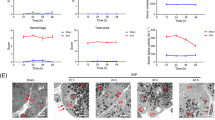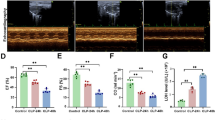Abstract
Purpose
Lgr5+ intestinal epithelial stem cells (ISCs) crucial for intestinal epithelial regeneration are impaired during necrotizing enterocolitis. This study aims to investigate the influence of different stressors on intestinal epithelial injury and regeneration in vitro.
Methods
Intestinal epithelial cells (IEC-18) were exposed to stressors such as lipopolysaccharide, hydrogen peroxide, and serum. Cell viability was assessed using MTT assay at 18 and 24 h. IL-6 and Lgr5 gene expressions were measured using qPCR.
Results
IEC-18 cell viability decreased 18 h following administration of lipopolysaccharide, hydrogen peroxide, and low serum concentration. However, after 24 h, the decrease in cell viability was observed only in higher, but not in lower concentrations of lipopolysaccharide and hydrogen peroxide. IL-6 expression increased in all groups compared to control. Lgr5 expression was up-regulated in cells exposed to a single stressor, but down-regulated when multiple stressors were administered.
Conclusion
Lipopolysaccharide, hydrogen peroxide, or low serum induced IEC-18 injury. The upregulation of Lgr5 expression after exposure to a single stressor suggests that minor injury to IEC-18 induces Lgr5+ ISCs to stimulate repair. Conversely, when IEC-18 cells were exposed to multiple stressors, Lgr5 expression was reduced. We speculate that this finding is similar to what happens in NEC when multiple stressors cause impairment of intestinal epithelium regeneration.



Similar content being viewed by others
References
Hall NJ, Eaton S, Pierro A (2013) Royal Australasia of surgeons guest lecture. Necrotizing enterocolitis: prevention, treatment, and outcome. J Pediatr Surg 48(12):2359–2367. doi:10.1016/j.jpedsurg.2013.08.006
Fox TP, Godavitarne C (2012) What really causes necrotising enterocolitis? ISRN Gastroenterol 2012:628317. doi:10.5402/2012/628317
Stoll BJ, Hansen NI, Bell EF, Walsh MC, Carlo WA, Shankaran S, Laptook AR, Sanchez PJ, Van Meurs KP, Wyckoff M, Das A, Hale EC, Ball MB, Newman NS, Schibler K, Poindexter BB, Kennedy KA, Cotten CM, Watterberg KL, D’Angio CT, DeMauro SB, Truog WE, Devaskar U, Higgins RD, Eunice Kennedy Shriver National Institute of Child H, Human Development Neonatal Research N (2015) Trends in care practices, morbidity, and mortality of extremely preterm neonates, 1993–2012. Jama 314(10):1039–1051. doi:10.1001/jama.2015.10244
Neal MD, Richardson WM, Sodhi CP, Russo A, Hackam DJ (2011) Intestinal stem cells and their roles during mucosal injury and repair. J Surg Res 167(1):1–8. doi:10.1016/j.jss.2010.04.037
Barker N, van Es JH, Kuipers J, Kujala P, van den Born M, Cozijnsen M, Haegebarth A, Korving J, Begthel H, Peters PJ, Clevers H (2007) Identification of stem cells in small intestine and colon by marker gene Lgr5. Nature 449(7165):1003–1007. doi:10.1038/nature06196
Carmon KS, Lin Q, Gong X, Thomas A, Liu Q (2012) LGR5 interacts and cointernalizes with Wnt receptors to modulate Wnt/beta-catenin signaling. Mol Cell Biol 32(11):2054–2064. doi:10.1128/MCB.00272-12
Kim TH, Escudero S, Shivdasani RA (2012) Intact function of Lgr5 receptor-expressing intestinal stem cells in the absence of Paneth cells. Proc Natl Acad Sci USA 109(10):3932–3937. doi:10.1073/pnas.1113890109
Sato T, Vries RG, Snippert HJ, van de Wetering M, Barker N, Stange DE, van Es JH, Abo A, Kujala P, Peters PJ, Clevers H (2009) Single Lgr5 stem cells build crypt-villus structures in vitro without a mesenchymal niche. Nature 459(7244):262–265. doi:10.1038/nature07935
Metcalfe C, Kljavin NM, Ybarra R, de Sauvage FJ (2014) Lgr5 + stem cells are indispensable for radiation-induced intestinal regeneration. Cell Stem cell 14(2):149–159. doi:10.1016/j.stem.2013.11.008
Smith RJ, Rao-Bhatia A, Kim TH (2017) Signaling and epigenetic mechanisms of intestinal stem cells and progenitors: insight into crypt homeostasis, plasticity, and niches. Wiley Interdiscip Rev Dev Biol. doi:10.1002/wdev.281
Afrazi A, Branca MF, Sodhi CP, Good M, Yamaguchi Y, Egan CE, Lu P, Jia H, Shaffiey S, Lin J, Ma C, Vincent G, Prindle T Jr, Weyandt S, Neal MD, Ozolek JA, Wiersch J, Tschurtschenthaler M, Shiota C, Gittes GK, Billiar TR, Mollen K, Kaser A, Blumberg R, Hackam DJ (2014) Toll-like receptor 4-mediated endoplasmic reticulum stress in intestinal crypts induces necrotizing enterocolitis. J Biol Chem 289(14):9584–9599. doi:10.1074/jbc.M113.526517
Nino DF, Sodhi CP, Egan CE, Zhou Q, Lin J, Lu P, Yamaguchi Y, Jia H, Martin LY, Good M, Fulton WB, Prindle T Jr, Ozolek JA, Hackam DJ (2017) Retinoic acid improves incidence and severity of necrotizing enterocolitis by lymphocyte balance restitution and repopulation of LGR5+ intestinal stem cells. Shock 47(1):22–32. doi:10.1097/SHK.0000000000000713
Leaphart CL, Cavallo J, Gribar SC, Cetin S, Li J, Branca MF, Dubowski TD, Sodhi CP, Hackam DJ (2007) A critical role for TLR4 in the pathogenesis of necrotizing enterocolitis by modulating intestinal injury and repair. J Immunol 179(7):4808–4820
Chen Y, Chang KT, Lian DW, Lu H, Roy S, Laksmi NK, Low Y, Krishnaswamy G, Pierro A, Ong CC (2016) The role of ischemia in necrotizing enterocolitis. J Pediatr Surg 51(8):1255–1261. doi:10.1016/j.jpedsurg.2015.12.015
Chen Y, Koike Y, Miyake H, Li B, Lee C, Hock A, Zani A, Pierro A (2016) Formula feeding and systemic hypoxia synergistically induce intestinal hypoxia in experimental necrotizing enterocolitis. Pediatr Surg Int 32(12):1115–1119. doi:10.1007/s00383-016-3997-8
Li B, Lee C, Filler T, Hock A, Wu RY, Li Q, Chen S, Koike Y, Ip W, Chi L, Zani-Ruttenstock E, Maattanen P, Gonska T, Delgado-Olguin P, Zani A, Sherman PM, Pierro A (2017) Inhibition of corticotropin-releasing hormone receptor 1 and activation of receptor 2 protect against colonic injury and promote epithelium repair. Sci Rep 7:46616. doi:10.1038/srep46616
Li B, Lee C, Martin Z, Li X, Koike Y, Hock A, Zani-Ruttenstock E, Zani A, Pierro A (2017) Intestinal epithelial injury induced by maternal separation is protected by hydrogen sulfide. J Pediatr Surg 52(1):40–44. doi:10.1016/j.jpedsurg.2016.10.013
de Groot RE, Farin HF, Macurkova M, van Es JH, Clevers HC, Korswagen HC (2013) Retromer dependent recycling of the Wnt secretion factor Wls is dispensable for stem cell maintenance in the mammalian intestinal epithelium. PLoS One 8(10):e76971. doi:10.1371/journal.pone.0076971
Bein A, Zilbershtein A, Golosovsky M, Davidov D, Schwartz B (2017) LPS induces hyper-permeability of intestinal epithelial cells. J Cell Physiol 232(2):381–390. doi:10.1002/jcp.25435
Barabutis N, Khangoora V, Marik PE, Catravas JD (2017) Hydrocortisone and Ascorbic Acid synergistically prevent and repair LPS-induced pulmonary endothelial barrier dysfunction. Chest. doi:10.1016/j.chest.2017.07.014
Wang X, Hao L, Bu HF, Scott AW, Tian K, Liu F, De Plaen IG, Liu Y, Mirkin CA, Tan XD (2016) Spherical nucleic acid targeting microRNA-99b enhances intestinal MFG-E8 gene expression and restores enterocyte migration in lipopolysaccharide-induced septic mice. Sci Rep 6:31687. doi:10.1038/srep31687
Chen S, Liu Y, Wang X, Wang H, Li S, Shi H, Zhu H, Zhang J, Pi D, Hu CA, Lin X, Odle J (2016) Asparagine improves intestinal integrity, inhibits TLR4 and NOD signaling, and differently regulates p38 and ERK1/2 signaling in weanling piglets after LPS challenge. Innate Immun 22(8):577–587. doi:10.1177/1753425916664124
Lim JC, Golden JM, Ford HR (2015) Pathogenesis of neonatal necrotizing enterocolitis. Pediatr Surg Int 31(6):509–518. doi:10.1007/s00383-015-3697-9
Ling X, Linglong P, Weixia D, Hong W (2016) Protective effects of bifidobacterium on intestinal barrier function in LPS-induced enterocyte barrier injury of caco-2 monolayers and in a rat NEC model. PloS One 11(8):e0161635. doi:10.1371/journal.pone.0161635
Zhu L, Liu YJ, Shen H, Gu PQ, Zhang L (2017) Astragalus and baicalein regulate inflammation of mesenchymal stem cells (MSCs) by the mitogen-activated protein kinase (MAPK)/ERK pathway. Med Sci Monit 23:3209–3216
Mehrzadi S, Safa M, Kamrava SK, Darabi R, Hayat P, Motevalian M (2017) Protective mechanisms of melatonin against hydrogen-peroxide-induced toxicity in human bone-marrow-derived mesenchymal stem cells. Can J Physiol Pharmacol 95(7):773–786. doi:10.1139/cjpp-2016-0409
Chen HY, Zhang X, Chen SF, Zhang YX, Liu YH, Ma LL, Wang LX (2012) The protective effect of 17beta-estradiol against hydrogen peroxide-induced apoptosis on mesenchymal stem cell. Biomed Pharm 66(1):57–63. doi:10.1016/j.biopha.2011.11.014
Xiao Y, Li X, Cui Y, Zhang J, Liu L, Xie X, Hao H, He G, Kander MC, Chen M, Liu Z, Verfaillie CM, Zhu H, Lei M, Liu Z (2014) Hydrogen peroxide inhibits proliferation and endothelial differentiation of bone marrow stem cells partially via reactive oxygen species generation. Life Sci 112(1–2):33–40. doi:10.1016/j.lfs.2014.07.016
Li B, Zani A, Martin Z, Lee C, Zani-Ruttenstock E, Eaton S, Pierro A (2016) Intestinal epithelial cell injury is rescued by hydrogen sulfide. J Pediatr Surg 51(5):775–778. doi:10.1016/j.jpedsurg.2016.02.019
Wu MF, Stachon T, Seitz B, Langenbucher A, Szentmary N (2017) Effect of human autologous serum and fetal bovine serum on human corneal epithelial cell viability, migration and proliferation in vitro. Int J Ophthalmol 10(6):908–913. doi:10.18240/ijo.2017.06.12
McLeod CJ, Wang L, Wong C, Jones DL (2010) Stem cell dynamics in response to nutrient availability. Curr Biol 20(23):2100–2105. doi:10.1016/j.cub.2010.10.038
Zani A, Zani-Ruttenstock E, Peyvandi F, Lee C, Li B, Pierro A (2016) A spectrum of intestinal injury models in neonatal mice. Pediatr Surg Int 32(1):65–70. doi:10.1007/s00383-015-3813-x
Baregamian N, Rychahou PG, Hawkins HK, Evers BM, Chung DH (2007) Phosphatidylinositol 3-kinase pathway regulates hypoxia-inducible factor-1 to protect from intestinal injury during necrotizing enterocolitis. Surgery 142(2):295–302. doi:10.1016/j.surg.2007.04.018
Feng J, El-Assal ON, Besner GE (2006) Heparin-binding epidermal growth factor-like growth factor decreases the incidence of necrotizing enterocolitis in neonatal rats. J Pediatr Surg 41(1):144–149. doi:10.1016/j.jpedsurg.2005.10.018 (discussion 144–149)
Jilling T, Simon D, Lu J, Meng FJ, Li D, Schy R, Thomson RB, Soliman A, Arditi M, Caplan MS (2006) The roles of bacteria and TLR4 in rat and murine models of necrotizing enterocolitis. J Immunol 177(5):3273–3282
Barlow B, Santulli TV (1975) Importance of multiple episodes of hypoxia or cold stress on the development of enterocolitis in an animal model. Surgery 77(5):687–690
Acknowledgements
This work is supported by Canadian Institutes of Health Research (CIHR) Foundation Grant 353857. AP is the Robert M. Filler Professor of Surgery, The Hospital for Sick Children (HSC), University of Toronto.
Author information
Authors and Affiliations
Contributions
C.L., A.M., B.L., and A.P. designed experiments; C.L., A.M., and B.L. performed experiments, analyzed data, and wrote the manuscript; H.M. and S.S. provided advice and comments; and all the authors revised the manuscript.
Corresponding author
Rights and permissions
About this article
Cite this article
Lee, C., Minich, A., Li, B. et al. Influence of stress factors on intestinal epithelial injury and regeneration. Pediatr Surg Int 34, 155–160 (2018). https://doi.org/10.1007/s00383-017-4183-3
Accepted:
Published:
Issue Date:
DOI: https://doi.org/10.1007/s00383-017-4183-3




